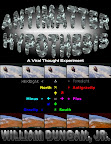Globular clusters are rural embryonic galaxies that harvest the intergalactic medium, which entails remnants from the grandparent’s generation of the protoplasm fed progeny.
In the second Hubble Space Telescope image below of elliptical galaxy NGC 1132, rural globular clusters, in the blue squares, and dwarf galaxies, in the red circles, abound. Age of these embryonic galaxies is a function of distance from the parent elliptical galaxy, and dwarf galaxies are larger than globular clusters, which is consistent with formation around departing black holes.
Elliptical galaxies harbor the oldest stars and contain relatively little dust, which makes them mature by galactic standards. Elliptical galaxies are considered by cosmologists to be the end result of galaxy mergers. Conventional cosmology claims that galaxies form from the outside-in.
Elliptical galaxy NGC 1275 harbors young globular clusters, appearing here as blue dots.
Globular clusters M15 and G1 harbor black holes.
Ultraviolet reveals the extended region of hydrogen protoplasm around irregular dwarf galaxy IC 1613. The image on the right represents the visual spectrum of the same area.
Globular cluster M4 in our Milky Way harbors old white dwarf stars, circled in blue, that are remnants of stars that have fused elements up to carbon and oxygen.
While nearby the Large Magellanic Cloud harbors young globular clusters just beginning hydrogen fusion.
NGC 1705 is an irregular dwarf galaxy with young hot blue stars concentrated near its core, which is consistent with central black holes in galaxies and globular clusters as the source of hydrogen protoplasm.
The change in matter polarity from generation to generation causes the expansion of the universe through the repulsive forces between normal gravity and antigravity. This accounts for the observed red shift, which takes care of a second pillar of Big Bang cosmology. The third pillar is cosmic microwave background radiation, and the leading candidate for this is blackbody radiation from the remains of countless preceding generations of matter and antimatter strewn throughout the intergalactic medium. All three pillars supporting the Big Bang are explained by the cyclical cellular cosmological model, but with greater simplicity. Science is like politics where the incumbent normally wins, but not always. Incumbent cosmology has unresolved problems but no paradigm peers; whereas this cosmological challenger has paradigm peers in many disciplines, including cellular biology, which makes cyclical cellular cosmology far easier to envision. The explanatory power of paradigm peers is a tremendous boon to any model.









No comments:
Post a Comment